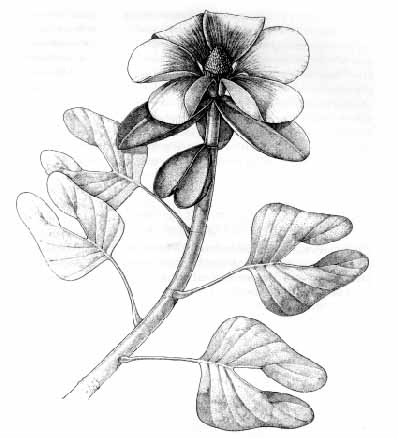
Paleobotany is the study of fossil plants, including their origin, evolution, and diversification on earth. The unique perspective obtained through study of plants that lived in specific past times and places allows paleobotanists to address directly hypotheses of plant origin, evolution, and diversification that are otherwise untestable. Paleobotany also encompasses study of past climates and communities and provides a
 |
|---|
| Flowering shoot of Archaeanthus linnenbergeri from the mid-Cretaceous (97 million years ago) of Kansas. This is an extinct plant that lived during the early phases of angiosperm radiation in which they became the dominant vegetation on the earth. Its reproductive biology appears to have coevolved with insect pollinators. From: David L. Dilcher and Peter R. Crane. 1984. Annals of the Missouri Botanical Garden 71:351-383; art work by Megan Rohn. |
The scientific goal of paleobotany is to provide an understanding of the origin, evolution, and diversification of plant life through the ages, and to provide an historical perspective for our understanding of plants within the dynamics of the Earth's biotic systems. Such understanding is essential for testing models and theories of global climate change, patterns of plant phylogeny, and the antecedents of current patterns of biodiversity. Paleobotanical research, through integration of biological and geological studies of the Earth and its biota, empowers policymakers by providing baseline data from which informed decisions can be made in the areas of conservation, ecology, and the reliability of climate models. The fossil record provides access to a much more complete sample of organisms than is available in the extant biota alone and is, therefore, of crucial significance in reconstructing evolutionary history. Fossils constitute a rich source of diversity for phylogenetic analyses, including transitional taxa or mosaics of characters not present today. Indeed, for many plant groups, extant diversity constitutes a limited and biased sample of the total diversity of organisms in those clades. Fossils provide a means of evaluating concepts of homology and species. The fossil record demonstrates the occurrence of physical events and evolutionary patterns that are not represented within the modern world. Ignorance of such historical patterns has often prevented their incorporation into evolutionary and environmental models. Plants are the dominant primary producers in all terrestrial ecosystems and thus provide the energy foundation on which all terrestrial animals depend. Because of their unique ecological status, fossil plants are central to understanding the organization and function of ancient communities, as well as changes in terrestrial ecosystems through time.
Implementation of this plan relies primarily upon adoption of the scientific goals and strategic priorities by funding agencies, particularly the National Science Foundation. The paleobotanical community is primarily academic in composition and thus relies on the initiative of individual investigators and research teams. The Paleobotanical Section of the Botanical Society of America will take responsibility for this agenda by working to implement the goals and priorities presented. Implicit in this research agenda is the assumption that graduate students in paleobotany have a broad training in areas such as phylogenetic theory, molecular systematics, morphology and anatomy, and paleobotany. Likewise, paleoecological investigators must have been trained not only in paleobotany, taxonomy, sedimentology (depositional environments), and biostratigraphy, but also in ecology, population biology, biogeography, and climatology.




